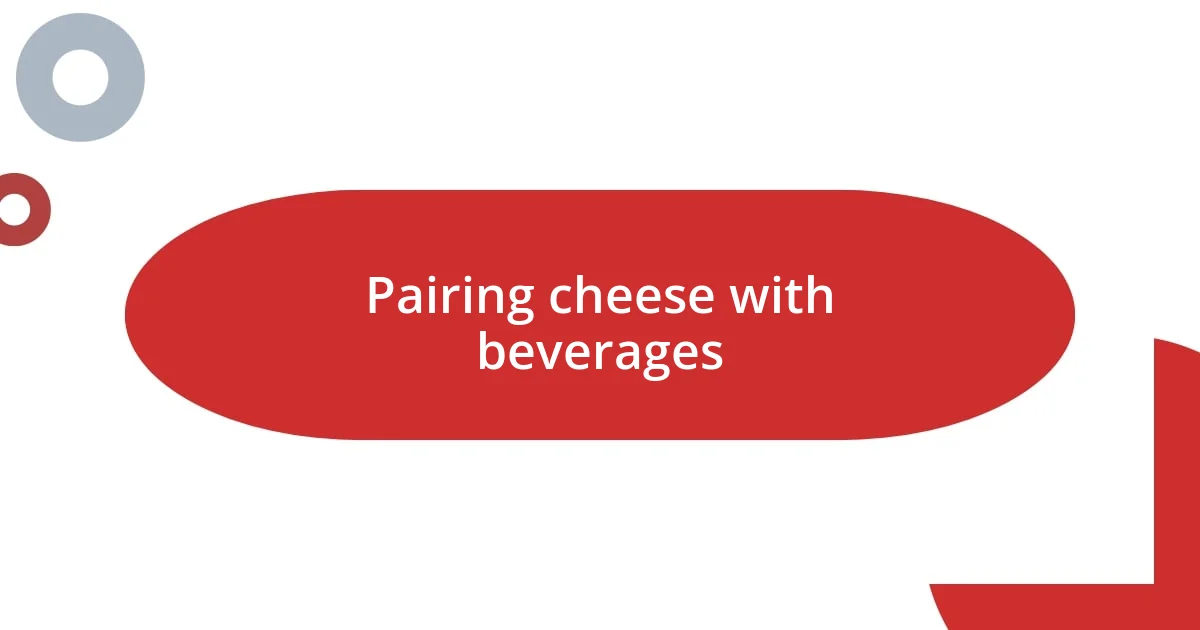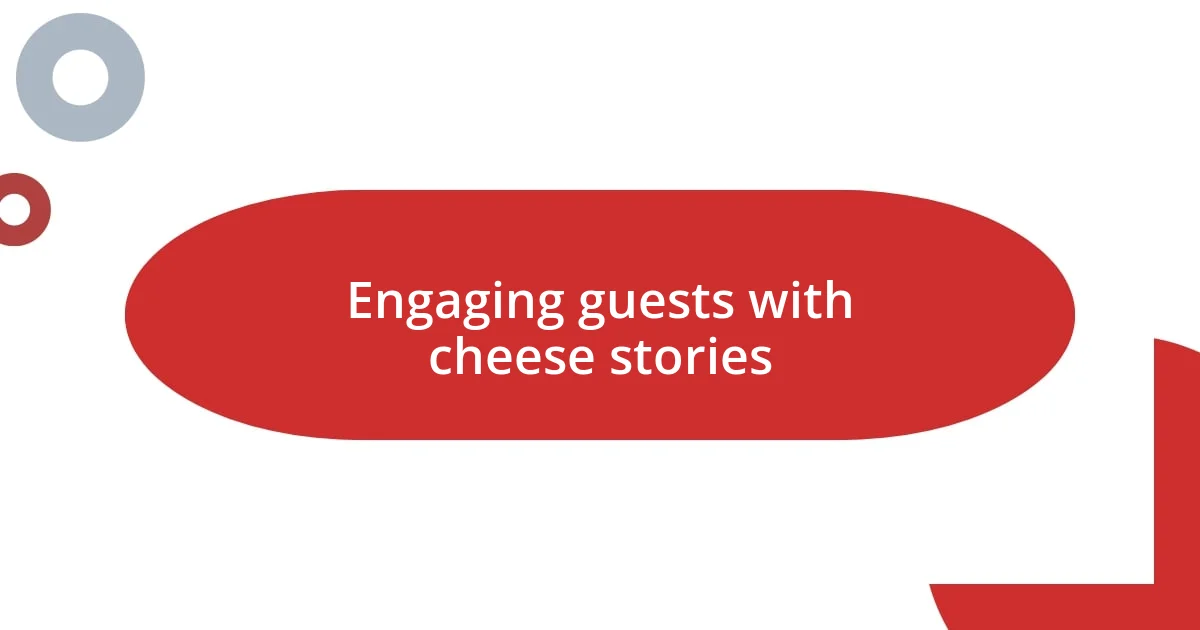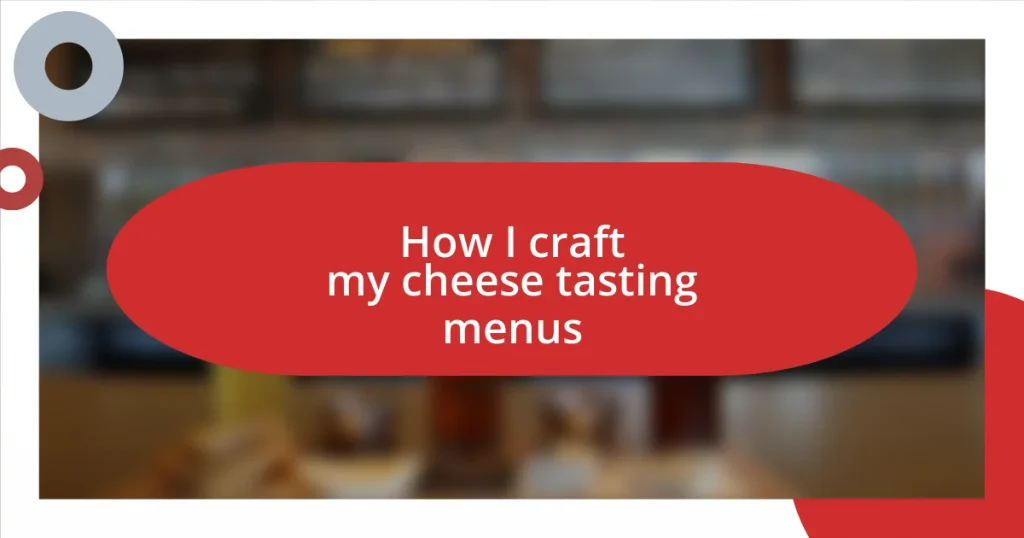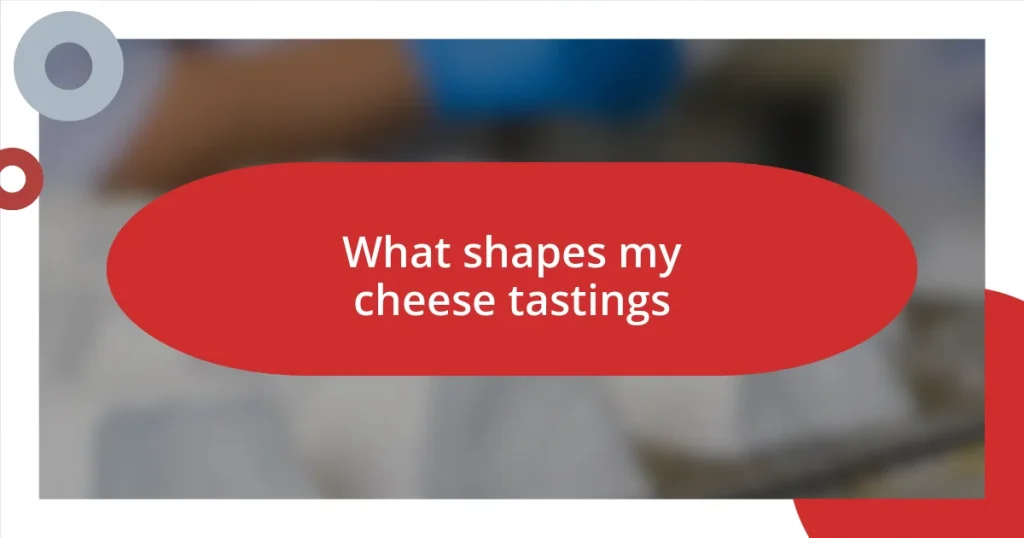Key takeaways:
- Creating a cheese tasting menu is an art that combines flavor storytelling, texture balance, and the inclusion of complementary elements to enhance the experience.
- Careful selection of cheese varieties, considering milk type, texture, aging, and regional diversity, leads to a memorable sensory journey and engaging conversations among guests.
- Thoughtful presentation and sharing cheese stories deepen guest connections, transforming a simple tasting into a meaningful and shared exploration of flavors and memories.

Understanding cheese tasting menus
Creating a cheese tasting menu is more than just selecting a variety of cheeses; it’s about weaving a narrative through flavor. Each cheese tells its own story, reflecting the region, the milk used, and the craft of the cheesemaker. Have you ever tasted a cheese that instantly transported you to a sun-drenched pasture? That connection is what makes cheese tasting so special.
When I curate a cheese tasting menu, I focus on balancing textures and flavors. I often start with a creamy brie, then transition to a sharper aged cheddar, and finally finish with a bold blue cheese. This journey through tastes not only enhances each cheese’s unique characteristics but also encourages conversation among guests. Isn’t it fascinating how one cheese can spark discussions about favorite pairings or unforgettable cheese experiences from childhood?
I’ve found that adding complementary elements—like fruits, nuts, and artisanal bread—elevates the tasting experience. It invites guests to explore contrasting flavors and textures, creating a more vibrant palate. Think about your own preferences: do you lean towards sweet or savory nibbles alongside your cheese? This interaction heightens the tasting experience and invites everyone into a shared exploration of flavor.

Choosing the right cheese varieties
When I select cheese varieties for my tasting menus, I aim for diversity, introducing my guests to a spectrum of flavors and textures. I often choose a foundational cheese, like a mild goat cheese, for its tangy freshness, and then layer in examples of different milk types—cow, sheep, and buffalo—to contrast their distinct characteristics. One memorable evening, I paired a luscious triple cream with a sharp, crumbly Pecorino. The guests were delighted to discover how the rich creaminess of one could elevate the robust salinity of the other, creating a delightful dialogue on their plates.
To make the selection process more intentional, I usually consider these factors:
- Milk Type: Cow, goat, sheep, or buffalo each impart unique flavors.
- Texture: Include creamy, crumbly, and hard cheeses for variety.
- Flavor Profiles: Balance mild, sharp, sweet, and pungent options.
- Aging: Range from fresh cheeses to aged varieties for depth.
- Regional Diversity: Highlight cheeses from different regions to tell a story.
This method not only transports my guests through an memorable sensory journey but also sparks conversations that transform an ordinary evening into an unforgettable experience.

Pairing cheese with beverages
Pairing cheese with beverages can truly elevate the overall tasting experience. My personal favorite has to be a creamy Camembert paired with a light, crisp Sauvignon Blanc. The wine’s acidity cuts through the richness of the cheese beautifully, creating a refreshing contrast that makes each bite and sip delightful. It’s moments like these that remind me how simple choices can lead to extraordinary sensations.
I’ve also enjoyed experimenting with more unconventional pairings, particularly with artisanal beers. For instance, pairing a tangy blue cheese with a rich stout can create a profound depth of flavor. The bitterness of the beer complements the cheese’s creaminess, while the chocolate notes in the stout enhance the cheese’s underlying saltiness. Have you ever found yourself surprised by how a bold combination can lead to such a rich tasting session?
A thoughtful approach to pairing can be a game-changer and often sparks lively conversations amongst guests. I recall an evening when a group of friends engaged in spirited debates over cheese and wine pairings. Someone preferred a bold red with a strong cheddar, while another insisted on a sweeter dessert wine with a sharp blue. These discussions not only entertained but demonstrated how pairing is ultimately about personal preference and experimentation, which makes the experience even more enjoyable.
| Cheese Type | Recommended Beverage |
|---|---|
| Camembert | Sauvignon Blanc |
| Blue Cheese | Stout |
| Aged Cheddar | Bold Red Wine |
| Goat Cheese | Dry Rosé |

Designing a balanced menu
Designing a balanced cheese tasting menu is all about harmony and contrast in flavors and textures. I personally like to create a flow that guides my guests through a sensory journey. For example, I might start with a fresh chevre, which is light and airy, and then gradually introduce more intense cheeses like a smoked Gouda or a strong Roquefort. It’s fascinating how the palate adapitates and grows during the experience, wouldn’t you agree?
I also pay close attention to the visual aspect of the presentation. I recall one memorable tasting where I arranged the cheeses on handmade pottery, contrasting creamy whites against rustic blues and deep, golden yellows. It wasn’t just a feast for the taste buds but also for the eyes! The guests were drawn to the colors and textures even before taking their first bite. How often do we eat with our eyes first?
Lastly, I think about the emotional experience I want to create. For instance, including a cheese that evokes memories—like the aged cheddar my grandmother served at family gatherings—adds a layer of nostalgia. I want my guests to feel a connection, to reminisce or celebrate while indulging in the flavors. What better way to share stories and flavors than to craft a menu that stimulates all senses? This thoughtful composition turns an ordinary gathering into a meaningful event.

Creating a themed cheese experience
Creating a themed cheese experience adds a delightful layer of intrigue to any gathering. I often choose a specific culture or region to inspire my selections, such as a French fare that features Brie, Comté, and Roquefort. The key is to weave a story around the theme—every cheese has a history, and I love sharing little anecdotes about their origins. For instance, talking about the caves where Roquefort is aged can truly captivate my guests’ imaginations.
I also enjoy playing with seasonal themes, like a cozy autumn evening featuring sharp cheeses paired with spiced apple cider. There’s something magical about inviting the warmth of fall into a cheese platter. I remember one chilly October evening, where the aroma of baked apples mingled with the rich scents of aged Gouda and a herb-infused cheese. The atmosphere felt alive, wouldn’t you say? It was as if the season itself was part of the tasting.
Another technique I use is to incorporate complementary foods, such as charcuterie, fruits, or artisanal bread, that resonate with the theme. During a Mediterranean-inspired evening, I added marinated olives and sun-dried tomatoes, enhancing the experience while drawing my guests deeper into the theme. I find it’s those little details—like the tang of a fresh fig or the crunch of a sesame cracker—that elevate the experience beyond just tasting cheese. What stories do you think your cheese platter could tell?

Presenting cheese elegantly
The way I present cheese can transform the entire tasting experience. I often use different boards or platters based on the type of cheese I’m serving; for creamy cheeses, a sleek marble slab emphasizes elegance, while a rustic wooden board brings warmth to sharper varieties. I remember one evening, I set out a vibrant selection of goat cheeses on a colorful hand-painted tray. Each cheese popped against the background, making it almost hard to choose where to start. Wouldn’t you agree that a visually striking presentation heightens anticipation?
I also consider the arrangement of the cheeses meticulously. Spacing them apart with small pots of honey or fig jam not only creates visual interest but also adds functional appeal; guests can easily navigate flavors without feeling overwhelmed. A personal favorite is when I use edible flowers or herbs as garnishes—they add an elegant touch and invite guests to explore their senses. I distinctly recall a summer gathering where fresh basil leaves not only looked stunning but also paired beautifully with a creamy burrata. Isn’t it marvelous how that little detail can spark conversation?
Creating an inviting atmosphere around the cheese is another crucial element in my presentations. I often dim the lights and use soft music to set the scene, which draws focus to the cheese as a centerpiece. During one particular evening, the ambiance felt like a cozy Italian vineyard, and as the robust aroma of a blue cheese filled the air, I noticed my guests exchanging excited glances. What memories do you think those flavors evoked for them? This emotional connection can elevate the tasting from an ordinary experience to something truly memorable.

Engaging guests with cheese stories
Engaging guests with stories about cheese is one of my favorite parts of hosting. I remember sharing the tale of Parmigiano-Reggiano with a group once. As I described the strict regulations and the pride that goes into making it, I could see their eyes light up. It’s incredible how a story can deepen appreciation—who wouldn’t be curious about the tradition behind a cheese that requires years of craftsmanship?
I also like to highlight the unique personalities of the cheesemakers. I once invited a featured artisan to discuss their process with my guests, and it transformed the atmosphere. The way they smiled when recalling their first cheese-making experience sparked a genuine connection among attendees. It made me realize: isn’t it fascinating how personal stories can create bonds over something as simple as cheese?
Sometimes, I draw parallels between the cheese’s flavor profiles and life experiences. For example, I compare the earthy taste of a well-aged cheddar to the comfort of home-cooked meals, evoking memories of family gatherings. When I hear someone murmur, “This cheese takes me back to my grandmother’s kitchen,” I know I’ve succeeded. What memories might your cheese stories evoke?















